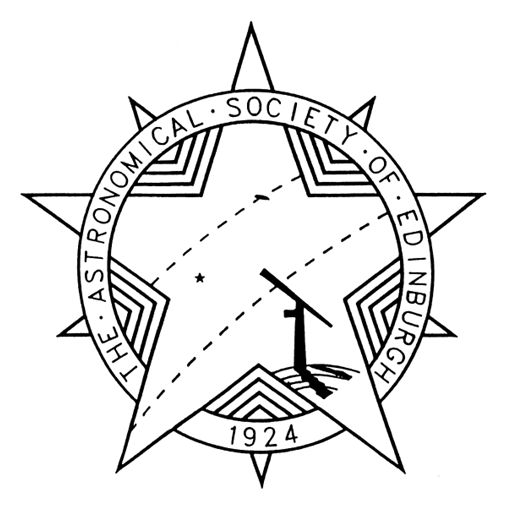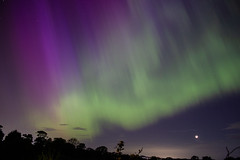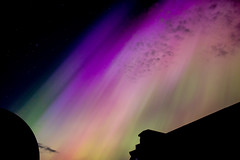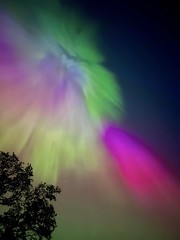Monthly Archives: August 2019
Scotland’s Sky in September, 2019
Friendly Delphinus the Dolphin wins a place among the stars
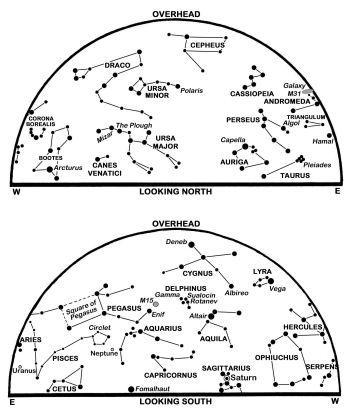
The maps show the sky at 23:00 BST on the 1st, 22:00 on the 16th and 21:00 on the 30th. (Click on map to enlarge)
The Sun’s southwards motion carries it across the sky’s equator at 08:50 BST on the 23rd, marking our autumnal equinox when days and nights are about equal around the Earth. It also means that our nights are lengthening at their fastest pace of the year.
The Summer Triangle (Vega, Deneb and Altair) remains in prime position high in the south at nightfall with the Milky Way flowing through it as it arches across the east from south to north. The brighter stars of Ursa Major, the Great Bear, form the familiar pattern of the Plough which stands in the north-west at nightfall as it begins to swing below the Pole Star, Polaris, in the north.
By our map times, the relatively empty expanse of the Square of Pegasus is climbing in the south-east while below it is the lengthy but dim constellation of Pisces, neatly book-ended by the Sun’s most distant planets Neptune and Uranus. Over the following few hours, though, this same region is invaded by the glorious form of Orion and his entourage of sparkling winter constellations
Last month I mentioned that Vega’s constellation, Lyra, was named for a lyre, but how that musical instrument came to be up there is associated with a myth that also involves Delphinus the Dolphin, a small but distinctive constellation that lies just to the left of the Summer Triangle.
That myth concerns Arion, a (real) poet and musician of ancient Greece. It has him returning by sea following lucrative performances in Sicily, only to be robbed and cast overboard before being rescued by a dolphin and delivered safely to shore. In gratitude, Apollo subsequently elevated the dolphin and Arion’s instrument, a lyre, to their places among the stars.
The four stars that represent the Dolphin’s head form a diamond or kite while telescope reveal that one of these, Gamma (see chart), is a superb double consisting of two stars of contrasting colours that appear only 9 arcseconds apart – in fact, they are separated by 330 times the Earth-Sun distance and take 3,200 years to orbit each other.
How two of the other stars in the diamond, Rotanev and Sualocin, came to be named was a mystery after they first appeared in a star catalogue issued by the Palermo Observatory in 1814. Then it was realised that spelled backwards they became Nicolaus Venator, the Latin equivalent of Niccolò Cacciatore which just happened to be the name of the assistant astronomer at the observatory. While his ruse succeeded, it is worth remembering that the modern craze for “buying” star names has no official standing and the names are not recognised by astronomers worldwide.
The prominent planet Jupiter is already past its best as the sky darkens and sinks from almost 10° high in the south-south-west to set in the south-west by our map times. Still brighter than any star, it dims slightly from magnitude -2.2 to -2.0 this month as it edges eastwards in southern Ophiuchus. The first quarter Moon stands 6° right of Jupiter on the 5th when a telescope shows it to be 38 arcseconds wide at its range of 767 million km.
Telescopes and good binoculars show Jupiter’s four main moons, Io, Europa, Ganymede and Callisto. Europa, with its ice-covered surface and likely sub-surface ocean, is of particular interest and the main target of a just-confirmed NASA mission, the Europa Clipper, which may launch as early as 2023 with arrival in 2026. This would see it beat the European Space Agency’s Jupiter Icy Moons Explorer (or JUICE) probe which is scheduled to launch in 2022 but only arrive at Jupiter in 2029. JUICE will explore all the main moons apart from Io, the volcanic innermost moon which appears to have less water than any other object in the solar system.
Saturn, our only other easy naked eye planet, is at its best at nightfall, albeit barely 12° high in the south and just below the so-called Teaspoon of Sagittarius. Non-twinkling and fading slightly this month between magnitude 0.3 and 0.5, Saturn moves to set in the south-west two hours after the map times. Catch it right of the Moon on the 8th when it appears 17 arcseconds wide with rings spanning 39 arcseconds and tipped 25° to our view.
Sunrise/sunset times for Edinburgh change from 06:16/20:08 BST on the 1st to 07:13/18:52 on the 30th. The Moon is at first quarter near Jupiter on the 6th, full near Neptune on the 14th, at last quarter above Orion on the 22nd and new on the 28th. On the 29th, the Moon’s sliver stands 6° high in the west-south-west at sunset and 3° above the evening star Venus. We have only the slimmest of chances of spotting the pair from our latitudes but binoculars may help – just don’t use them until the Sun is safely below the horizon.
We do need binoculars, at least, to see either Neptune and Uranus which shine at magnitudes of 7.8 and 5.7 respectively. Neptune lies in eastern Aquarius where it tracks 0.8° westwards during the month to pass a mere 13 arcsecond south of the naked-eye star Phi Aquarii (magnitude 4.2) on the 6th. At that time, just four days before it reaches opposition, Neptune lies 4,328 million km away and appears as a tiny 2.3 arcsecond bluish disk. Being seven times brighter, Uranus would be easier to recognise were it not in a star-sparse region in south-western Aries.
Of the other planets, Mars is in conjunction on the Sun’s far side on the 2nd, as is Mercury two days later, while both remain hidden in the Sun’s glare.
Diary for 2019 September
Times are BST
2nd 12h Mars in conjunction with Sun
4th 03h Mercury in superior conjunction
6th 04h First quarter
6th 08h Moon 2.3° N of Jupiter
8th 15h Moon 0.04° S of Saturn
10th 08h Neptune at opposition at distance of 4,328 million km
14th 06h Full moon
18th 07h Saturn stationary (motion reverses from W to E)
20th 18h Moon 2.7° N of Aldebaran
22nd 04h Last quarter
23rd 08:50 Autumnal equinox
24th 23h Moon 0.7° N of Praesepe
26th 10h Moon 3° N of Regulus
28th 02h Moon 4° N of Mars
28th 19h New moon
29th 23h Moon 6° N of Mercury
Alan Pickup
